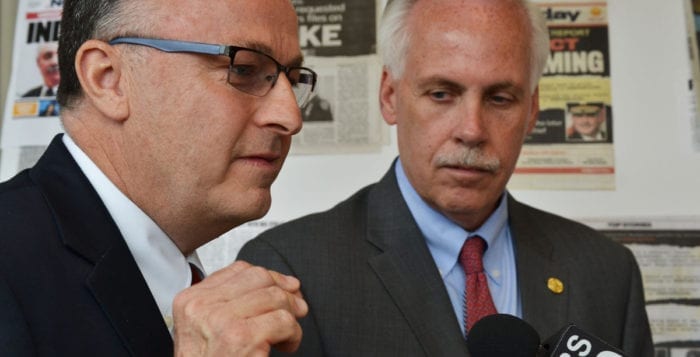The road to fairness for farmworkers starts in Suffolk County.
Supporters of the Farm Workers Fair Labor Practices Act, as it has been known for the majority of its existence, which has spanned years and decades, will begin a 200-mile march to Albany on May 15, starting from Sen. John Flanagan’s (R-East Northport) office in Smithtown. A group called the Rural Migrant Ministry organized the March for Farmworker’s Justice. The group has been lobbying for better working and living conditions and benefits like overtime pay and health insurance for farmworkers, who Linda Obernauer, a volunteer with the ministry, said “live in fear” under “strongholds” from many farmers.
“The owners of the farm are the landlords — the owners of the housing,” Boris Martinez, a farmworker from a nursery in Patchogue, said through translator Katia Chapman in a phone interview Tuesday. Martinez is from El Salvador and has worked at the nursery for about two years, he said. “The owners only care that the housing is okay when inspection is going to come. They don’t care what state the housing is in, what condition the housing is in. It’s most likely that there will be at least 10 people living there.”
Nathan Berger is the main organizer of the march, which is a yearly occurrence. Participants march between 10 and 15 miles per day, stopping overnight to sleep at churches or at homes provided by volunteer host families. Obernauer said anyone is welcome to march, and they can join during any leg and participate for as many or as few miles as desired. Berger could not be reached for comment.
“We should all be involved in this,” Obernauer said in a phone interview Friday. “They are who we are but we don’t give them justice.”
Martinez said during a snowstorm last year many of the rooms in the housing provided by the owner of the farm where he works had leaks. Snow and water got inside of virtually all of the rooms. About 10 tenants share the home at a given time.
“The difficulty is that if we were to say to the owner that it’s not adequate housing he would send us out of the house to rent elsewhere because here when you work at his farm we don’t pay rent and it would be difficult to afford rent elsewhere,” Martinez said. “None of the workers are paid overtime pay. None of us have health insurance and if we get sick we don’t have the resources to pay for basic medical care. I know a lot of other workers in the area and none of them are paid overtime pay. Many of us don’t have a day of rest either. I’m right now working about 60 hours a week but when the weather warms up I’ll probably be working 67 or 68 hours.”
“The owners only care that the housing is okay when inspection is going to come.”
— Boris Martinez
Martinez added he has friends who work upward of 80 hours a week.
“Those in power, they don’t care how we’re doing as workers, what they care about is the money that we’re producing for them,” he said.
An anonymous website, located at www.nyfarmworkerprotectionbill.com, provides the farmers’ perspective on the seemingly never-ending battle. An attempt to contact the purveyor of the website was unsuccessful. The email associated is no longer active.
“[The Rural Migrant Ministry] and others have recruited various celebrities and ‘foodies’ to support the bill, as well as downstate/New York City legislators, most of whom have never even been to a farm,” the site says. “We believe these individuals have been misled and have not done the proper research to find out the truth about farms, growers, farmworkers, and the challenges we face to bring fresh food to as many tables as possible.”
State Assemblywoman Catherine Nolan (D-Queens) is the sponsor of the bill in its current form. The site suggests increased rights and benefits for farmworkers would take a financial toll on farmers’ businesses.
“What we are talking about are five or six exemptions to state labor law,” the site states. “These exemptions, like the one for overtime pay exist because of the production and marketing realities associated with farming. Farming does not take place in an enclosed building with a regulated environment. We have a limited time to plant and harvest. If overtime is enacted, farmers will have to cut hours during the growing season so as to afford the extra hours needed at planting and harvest times which can’t be avoided.”
Flanagan was a sponsor of the bill during his time in the State Assembly in the early 2000s. Since being elected to the State Senate in 2002 he has publicly supported the bill. However, despite becoming the GOP majority leader in 2015, the bill remains before the Labor Committee and has yet to pass the Senate. Flanagan did not respond to multiple requests for comment through his public relations personnel.
Jose Ventura, another farmworker from Guatemala who lives on Long Island, said his living and working conditions are not bad, but he also does not receive overtime or health benefits. He will be participating in the march.
“I’m participating in the march because even though, as I said, I like my job, I also see my friends, my companions that they are not always treated well,” Ventura said in a phone interview Tuesday through Chapman as a translator. “On their farms they’re not always paid fairly. There’s a lot of Guatemalan farmworkers and some of them are mistreated in the job and while I feel that this march is for the benefit of my people, therefore I feel motivated to be a part of the movement.”
Martinez, who also plans to participate in the march, said he knows his value and plans to fight for it.
“Farmworkers are the most important workers in every country because they’re the ones producing the food for the country.”
















